7 Common Cannabis Plant Mutations

- 1. Unusual number of “fingers” on the leaves
- 2. Unusual leaf shape
- 3. Plant topping itself
- 4. Twin seedlings
- 5. Buds growing on the center of the leaf
- 6. Leaves with unusual color patterns
- 7. Seedlings with three leaves
- 8. Is hermaphroditism a mutation?
- 8. a. What causes a cannabis plant to turn into a hermaphrodite?
- 9. Other issues that may affect cannabis crops
- 9. a. Nutrient deficiencies
- 9. b. Ph issues
- 9. c. Pest infestations
- 9. d. Mold and disease issues
- 9. e. Environmental control issues
- 10. In conclusion
Mutations in cannabis plants are a natural occurrence that can change a plant’s characteristics and is most common in the leaves, flowers, and stems. Now, there are a couple of mutations that can affect cannabis seeds, in general, most mutations that don’t cause a deformity (or malformation) will cause your plant to grow odd without affecting its health, allowing your plants to grow normally. These mutations can cause your plant to exhibit different colored leaves, grow an odd number of apexes (number of fingers on the leaves) or even grow more branches than it should; Most growers prefer not to grow mutated plants but it can be fun and you could learn a lot by seeing how a mutated cannabis plant grows. So here are the most common cannabis plant mutations that will still allow your plant to grow normally and produce decent yields if grown properly, obviously.
1. Unusual Number of “Fingers” On The Leaves
An unusual number of “fingers” in each fan leaf is considered to be a mutation in some cases, but can also be just a characteristic of that strain’s genetics. Despite the “standard” number of apexes (or “fingers”) being 7, it’s very common to see hybrid strains with more or fewer apexes, depending on the genetic mix. However, there are several different mutations that can affect not only the number of apexes, developing more apexes than usual (or less), but also how they grow. For example, some strains can grow up to 11 apexes or even more, which can be due to genetics (if they grow properly) or a mutation if the growth is unusual, like in the following image.

As you can see in the images above, this mutation can occur in different ways but in all cases, the leaves fingers will grow differently than what you’re used to. Now, this type of mutation does not apply only when the leaves grow a lot of apexes, this kind of mutation can also cause the leaves to grow fewer apexes than the specific strain should. These one-fingered leaves are very common to the leaves that develop when a photoperiodic plant is revegetating but you won’t get confused because revegetating occurs when your plant is already flowering and the light cycle changes back to 12/12. The one-fingered leaves will only start growing after that change happens whereas, when the cause is a mutation, the one-fingered leaves will grow since germination.
2. Unusual Leaf Shape
Apart from the unusual number of apexes, cannabis leaves can also grow with an unusual shape which is also a mutation although it can be harder to come by than the unusual number of apexes. In most cases, leaf shape will most likely not affect plant growth, your plant will grow as it should but, obviously, with different leaves. It is also possible to get a mutation that affects a couple of leaves, so your plant will grow regular leaves with a couple of mutated leaves here and there.
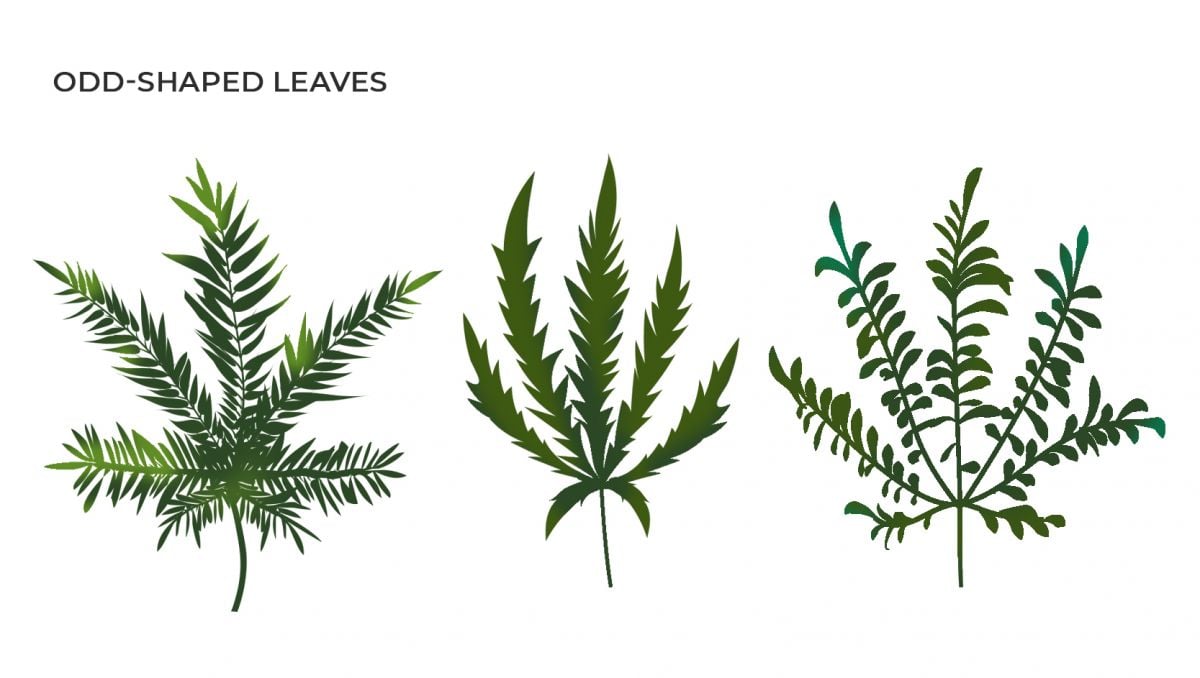
Nowadays, there are a lot of growers and breeders that look after these mutations and try to stabilize them, this is why you can find multiple strains that produce leaves like the ones you can see in the images above. This occurs because when a breeder finds a mutation, they will crossbreed it until the random mutation becomes a full strain, with an offspring that will always develop the same mutation.
3. Plant Topping Itself
A self-topped plant does basically what most growers who perform high-stress training techniques do, top the plant. This causes the plant to not develop a main cola but several side branches instead, resulting in a plant that grows low and bushy instead of tall, just like your plant would when topped.
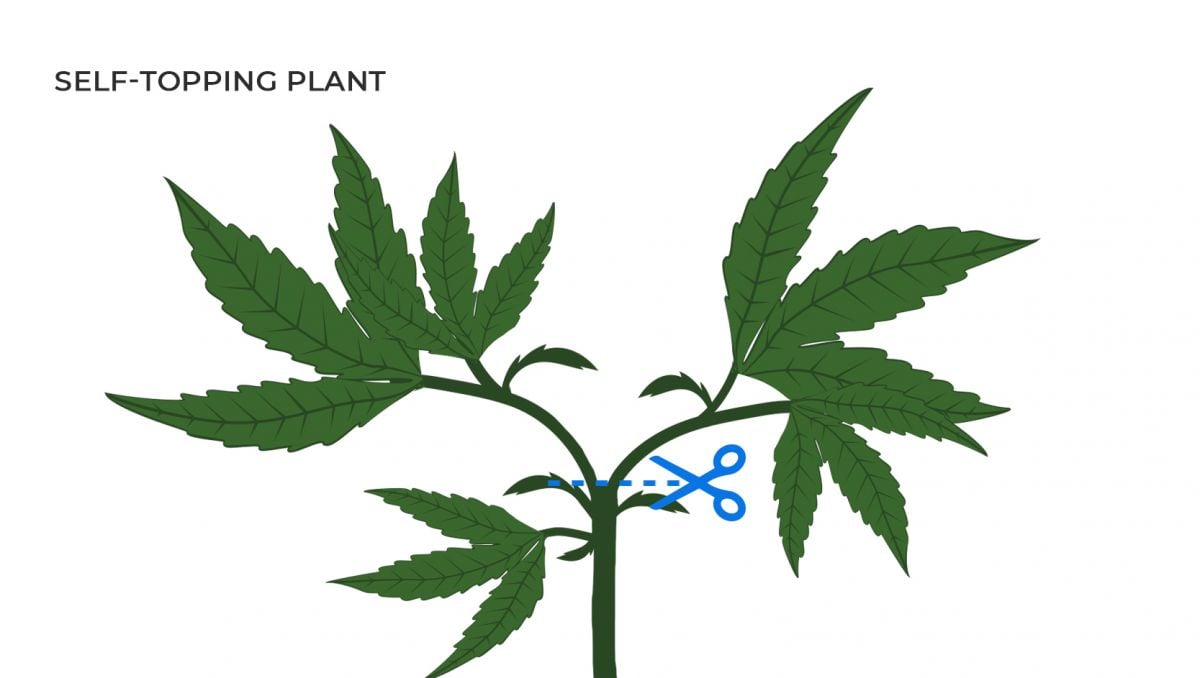
When your plant is self-topped, there shouldn’t be a problem other than your plant growing topped but in some cases, this self-topping mutation may come with other mutations such as the one in the second image where the plant grew one-fingered leaves where it should have grown the main cola.
4. Twin Seedlings
Just like it happens with other living beings, cannabis plants can also grow twins; This happens when two seedlings come out of one single cannabis seeds, both of these seedlings will have the potential to form a separate plant and grow normally but in some cases, one of them may grow shorter and more fragile.
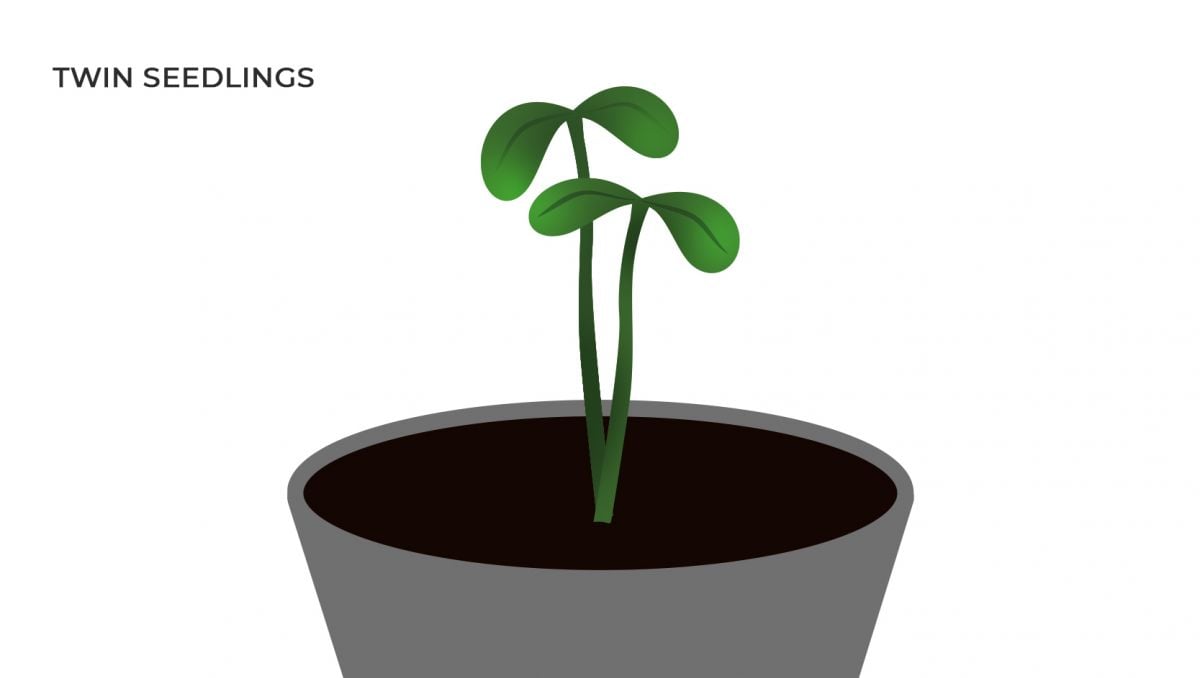
This happens because the bigger seedling will most likely take over the space both of them are growing in and the smaller one will end up dying so you can always let them be or separate them, either way, they should grow normally.
5. Buds Growing On The Center of The Leaf
Mutations don’t always apply to the fingers of the leaves, mutations can appear in different ways and sometimes will definitely surprise you. There have been reports of buds growing on the center of the big cannabis fan leaves, as you may know, the leaves don’t contain much THC but when this mutation occurs, you will have lots of resin growing from the center of each leaf. As you can see, there’s a flower forming in the center which is definitely not common.
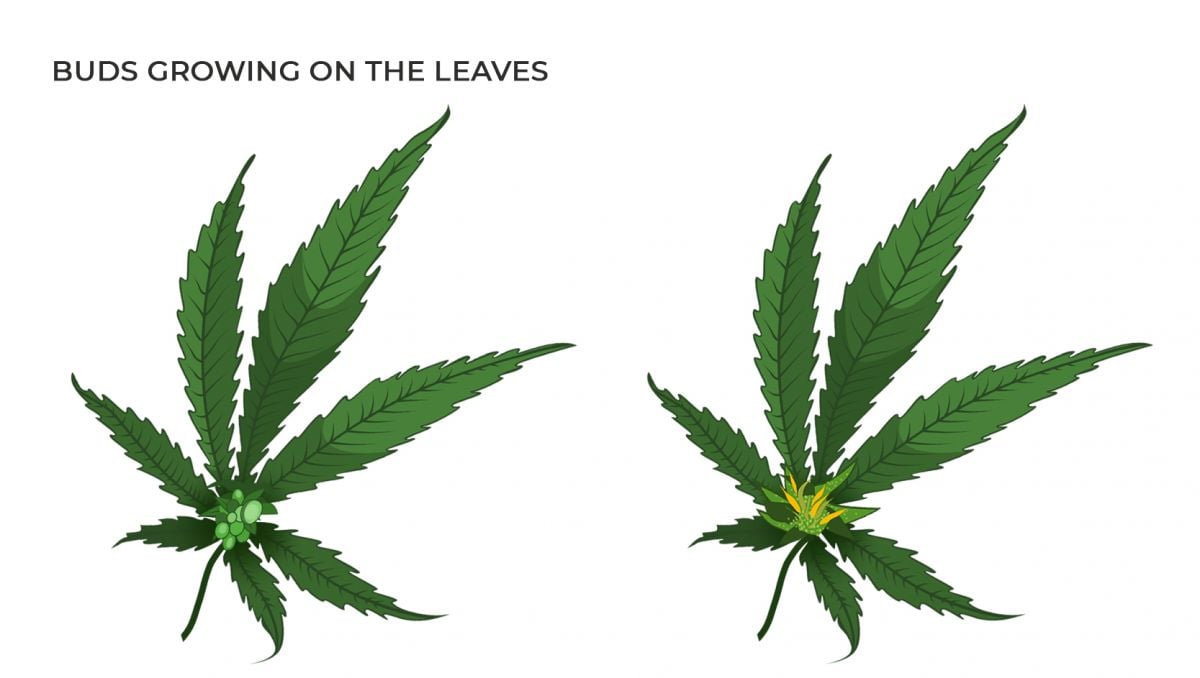
Despite not being big buds, you can definitely smoke them and make edibles, extractions, or whatever you prefer; Now, this mutation doesn’t actually make the plant grow buds on the leaves, it makes them grow a flowering site. This means that the plant can also grow pollen sacs on the leaves if it ends up being a male or turn into a hermaphrodite so, if this happens in your grow space, make sure you separate it from the others because it will pollinate your female plants.
6. Leaves With Unusual Color Patterns
Unusual color patterns may be caused by mainly two things:
- The tobacco mosaic virus;
- Or variegation.
These unusual color patterns are often confused with the TMV (tobacco mosaic virus) but unlike the TMV, this isn’t caused by a virus but by a genetic mutation. Unusual color patterns (aka variegation) usually present themselves by splitting the plant, stem, or buds in two, where each side has a different color. No one knows exactly what colors a plant may present, but there have been cases that which half of the leaf (or the whole plant) turns white, yellow, or purple.

These mutations are not a nutrient deficiency or any other problem and cannot be fixed, your plant will grow as it should but the buds, stems or part of the plant will show an unusual color. Have in mind that variegation doesn’t affect your plant, your plant will be able to grow normally despite the odd colors, also remember that this mutation is more common on the leaves or stems but it’s possible for the whole plant to be affected when this happens even the buds will turn white, yellow, purple or any other color but don’t worry, they are no less potent or anything, they’re just showing a different color.
7. Seedlings with Three Leaves
As you may know, cannabis seedlings grow with just 2 round leaves (aka cotyledons), but sometimes the seedling may have a mutation and grow 3 leaves. Now, this won’t affect plant growth and sometimes the plant grows out of it and starts growing normally so you should treat your triple seedling normally.
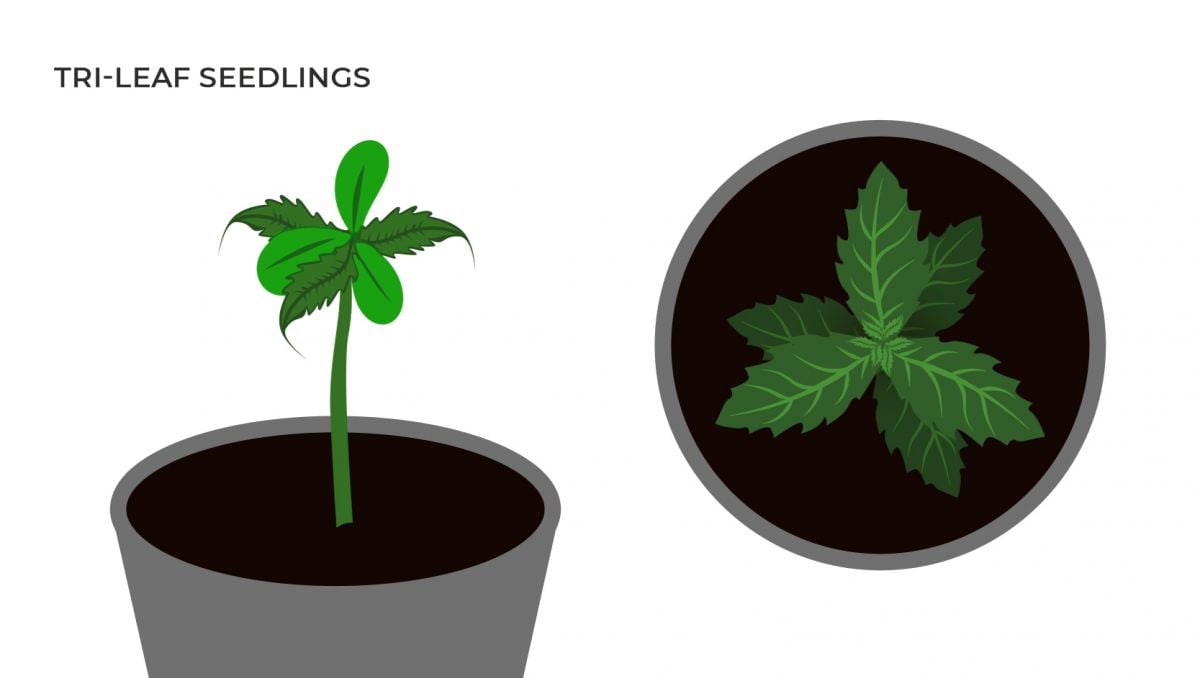
But in some cases your plant won’t grow out of it and will continue to develop triple leaves and branches; This isn’t bad, the only thing that will be affected is the plant’s appearance but it may be an advantage for those who grow in a SCROG setup or want to LST their plants.
8. Is Hermaphroditism a Mutation?
Hermaphroditism in cannabis is a naturally occurring feature, and while it is a defense mechanism inbuilt into the plant’s genetic code, it is a characteristic that we as cultivators want to always avoid. Hermaphrodite weed plants develop both masculine and feminine sexual traits, which means that while there will be budding sites present with fully formed flowers, there will also be pollen sacks that will definitely dust these flowering sites and cause them to be packed full of seeds. This has a huge evolutionary advantage, as a self-pollinating plant will always ensure its genetic lineage is passed on to the next generation. But, when growing weed for consumption, the very last thing we want is for seed to be present in our crop. A pollinated cannabis plant expends a huge amount of its energy on producing healthy seeds, which takes away from the amount it can spend on growing the biggest, densest buds possible. The result is a smaller yield with fewer trichomes and way less terpene production.
What Causes a Cannabis Plant to Turn Into a Hermaphrodite?
There are two causes of hermaphroditism in weeds - genetic markers and environmental stress. Certain strains of weed are just way more genetically predisposed to turning into hermies, with pure Sativa and Sativa-dominant cultivars having a much higher chance of switching when compared to Indica-dominant strains. Thai Sativas, in particular, seem to have the highest rates of hermaphroditism out of any strains that have been studied so far.
No matter the amount of genetic sensitivity, a certain strain may or may not have, every single cannabis plant has the chance of becoming a hermaphrodite by the direct influence of stress. If a flowering plant “feels” that the environmental conditions are not suited to flowering or pollination, she may switch over and become a hermie and can do so at the drop of a hat. Certain stress factors have a direct influence on the chances of a weed plant becoming a hermie, with the most impactful being:
- Physical damage to the plant structure
- Overfeeding or underfeeding
- Thermal stress (which happens when you feed your crop with water that is too cold or hot)
- Interruptions to the lighting period
- Light leaks into the grow area
- Overly warm ambient temperature conditions
- Underwatering and overwatering
- Pest, mold, fungal, or viral infestations
- Overuse of pesticides, fungicides, or insecticides
- Missing the harvest deadline
What Steps Can Be Taken to Ensure Your Plants do NOT Become Hermies?
The name of the game here is reducing or totally avoiding any of the stress-inducing situations listed above leading into, and during the flowering period. Providing the optimal environmental conditions is key, as is getting any and all plant training over and done within the vegetative or pre-flower growth stages. Essentially you want to get the plant good and ready before those buds start to properly develop, otherwise you may be in for some hermie trouble. Keeping the grow area as sterile as possible will help with reducing the chances of any pest, mold, fungal, or viral infestations taking hold, and prevention is always the best tool for battling these issues. You should be conducting daily checks for these issues anyway.
Regularly check all timers you have in place to ensure no unexpected interruptions or changes to the lighting periods and light leakproof the area as well as you can. If you have any other automated systems, such as timers for drip feeders or temperature and humidity controls, then these should also be checked for normal operation at least a few times a week. Watering the crop with a properly balanced nutrient solution is highly important, so make sure you invest in a decent pH meter and a TDS or EC pen. Knowing the correct amount of feed water to give a plant comes down to your growing style, and how much experience you have. For beginners, we always suggest starting out with coco-coir cultivation, which you should be watering until you see about 25% runoff.
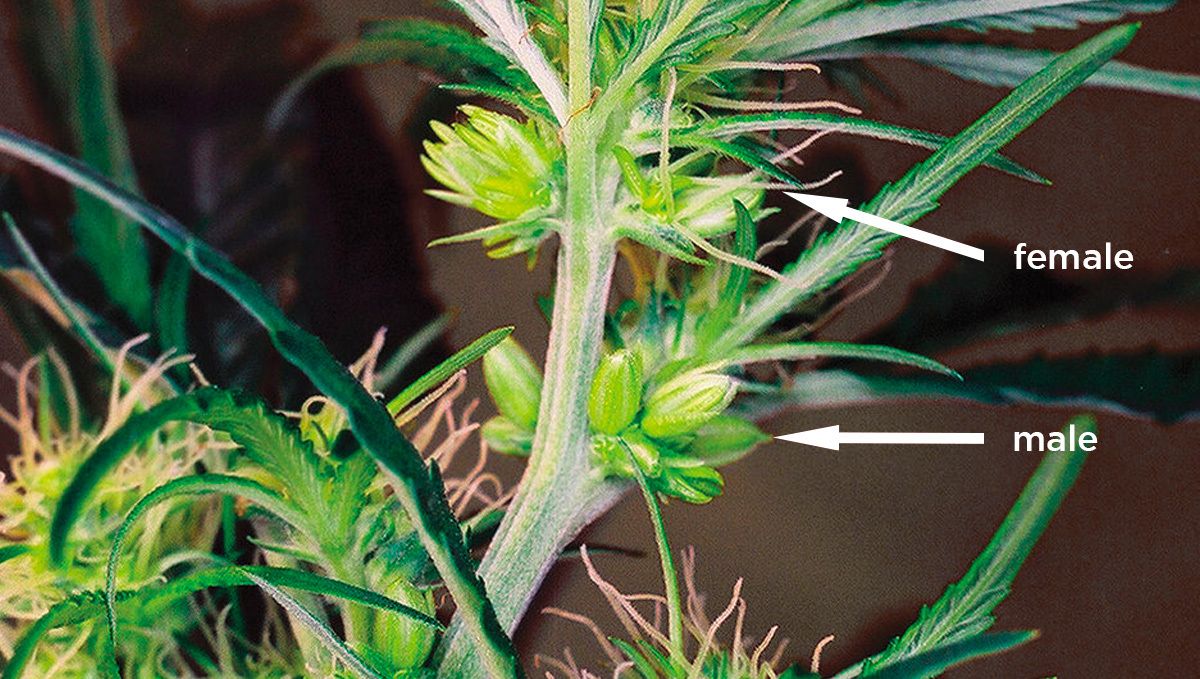
You can’t control the genetics of a cannabis strain, but you can choose strains with lower chances of hermaphroditism. All trustworthy seed banks should have customer reviews that are easily accessible, so be sure to read up on what previous growers have experienced with each and every strain you choose to grow. Regular, unfeminized seeds do have a slightly lower percentage of hermies, but then you have to deal with the possibility of the whole (or at least a large percentage) crop being male anyway, which is even worse than a full hermie or pollinated female crop.
What to Do If You Find That One Of Your Plants Has Turned Hermie?
If one or more of your plants start to show both male and female characteristics at the start of the flowering cycle you have two options available. If the plant is only showing a couple of male pollen sacks, and it seems like it is a localized problem that hasn’t spread to the entire plant then you can go ahead and very carefully try to remove the sacks. You can use tweezers for this job, just be very careful not to pop them. This doesn’t ensure that no more sacks will grow, but there is a chance that the plant will continue with normal female flowering from this point onwards. This is a risky strategy though because you could easily miss one of the tiny pollen sacks which could go on to quickly pollinate the entire crop. Disaster.
The other, more recommended practice is to go ahead and remove the plant from the crop and eliminate it. This ensures that there is no chance that the rest of the crop could be affected. If you notice the male flowers forming near the end of flowering you have one more viable option - quarantining the plant from the rest of the crop, removing the pollen sacks as carefully as possible, and just harvesting the flowers earlier... Sure, you will probably end up with a few seeds, but what’s the point of wasting all that great bud that you have poured your heart and soul into growing just because it contains some seeds? These flowers are perfectly fine to smoke, and they can be used for making edibles or concentrates.
What to Do With Seeds From Hermie Plants?
This is a bit of a contentious subject among cannabis cultivators. Some say that seeds from hermie plants should be thrown away and forgotten about, while some are of the thinking that since the seed inherent all the genetic information from the mother. That means that if you were growing a feminized seed that went hermie, all the seeds should also be feminized. One thing to keep in mind though is that all the seeds produced will have also inherited the genetic markers for hermaphroditism, so if you are wanting to eliminate the chances of hermies ever appearing in your grow space then chuck those seeds out and start again.
9. Other Issues That May Affect Cannabis Crops
Apart from plant mutations there is a range of issues that can, and will (given the chance), negatively affect cannabis plant growth and development. From nutrient deficiencies to pest and disease infestations to extreme temperatures or environmental conditions, many of these issues can be prevented with proper care and attention.
Nutrient Deficiencies
Cannabis plants require a range of essential nutrients for optimal growth. The three main macronutrients are nitrogen (N), phosphorus (P), and potassium (K) - but there are plenty more that are also absolutely vital to ensure your crop is vibrant and healthy. When any of these essential nutrients are deficient, the health and vigor of the plant can be compromised - leading to yellowing leaves, stunted growth, or even death.
Nitrogen Deficiency
Nitrogen is one of the most important nutrients for cannabis plants, especially during their vegetative state. When nitrogen levels are insufficient or deficient in a cannabis crop, it can lead to slowed or stunted growth and an overall decline in overall plant health. Nitrogen deficiencies usually start from the lower leaves and work up, turning them yellow and eventually brown as the deficiency worsens.
Phosphorus Deficiency
Without sufficient amounts of phosphorus, cannabis plants struggle to produce the enzymes needed for proper growth. As a result, vegetation can become stunted and buds will also suffer from slowed growth. Phosphorus deficiencies usually start on the lower leaves too - but instead of yellowing, they will appear dark green or even purplish-blue in color, and will eventually become dry and brittle.
Potassium Deficiency
One of the more serious nutrient deficiencies, potassium deficiency is often caused by an imbalance in other nutrients or environmental conditions. Symptoms usually start from the leaf tips and margins of the leaves, which will turn yellow or even brown. The edges of the leaves may appear crispy or mottled, and growth will be slowed significantly.
Micronutrient Deficiencies
Apart from the three primary macronutrients, cannabis plants also require several micronutrients to ensure optimal health and growth. These include calcium, iron, magnesium, and zinc - as well as lesser-known elements such as boron, molybdenum, and sulfur. When any of these are deficient, it can lead to stunted growth, wilting, yellowing leaves, plus a range of other issues. For our full and unabridged guide on plant deficiency issues, please refer to this guide.
PH Issues
Directly related to nutrient deficiencies are issues with the pH of both the water or nutrient solution you use to feed your crop, and also the pH range in the substrate you are using. If the pH of your water or nutrient solution is too low (acidic) or high (alkaline) it can prevent plants from absorbing, and therefore making use of, the essential nutrients they need to thrive.
This is known as pH or nutrient lockout, and it can be pretty hard to diagnose as it presents in the same way as nutrient deficiencies. To avoid any issues, it’s important to test for both pH and nutrient levels in your water or nutrient solution at the time of feeding and to also check the pH of the runoff from the pots after watering. You can also grab a pH soil tester which should give you a bit of a clearer idea of what's going on in the root zone, but as long as you provide the crops with water in the correct pH range then you shouldn't run into any real issues of this sort.
Pest Infestations
Just like all plants, cannabis crops are susceptible to pest infestations. Common cannabis pests include spider mites, aphids, whiteflies, and even fungus gnats - but the list is almost never-ending. The best way to ensure your crop stays pest free is to run preventative measures. These include regularly inspecting the crop for signs of a pest infestation and disposing of any affected plants, installing sticky traps or sprinkling a generous serving of Diatomaceous Earth (DE) on the soil and around the pots, in addition to keeping your crop clean and well-ventilated.
Outdoor crops are more affected by pest infestations than indoor grow areas, but that doesn't mean you can let your guard down if you grow indoors exclusively. For indoor growers, cleanliness is of the highest importance. That means disinfecting any tools and equipment you use to work on the crop, as well as regularly wiping down or vacuuming the walls and floor of your grow area, and giving the room or tent a proper deep clean between crop runs - make sure to use a good disinfectant and give the entire area a proper wipe down.
Mold and Disease Issues
Mold and disease can potentially be just as devastating to a cannabis crop as pests, if not more. Diseases such as powdery mildew, phytoplasma, sooty mold plus a range of others can all cause significant damage and ruin an entire harvest. The best way to prevent disease is to ensure your crop has adequate ventilation, humidity levels are kept in check, and all tools and equipment used to work with the crop are spotlessly clean. This goes back to the last point of always keeping your grow area as clean and tidy as possible. If you do so, you'll have a much higher chance of skipping mold and disease annoyances
In addition, you should also always use quality nutrient solutions if possible - In this new age of cannabis legality, the market has been flooded with low-quality, cheap nutrient options. Brands like APTUS, CANNA, House & Garden, and Advanced Nutrients (plus a bunch of other top-tier nutrient ranges) should always be your go-to.
Environmental Control Issues
Environmental control issues are something that many growers face, and it's usually one of the most challenging aspects of modern cannabis cultivation. If your environment isn't kept in check, then you can end up with issues such as wilting, nutrient lockout, pest infestations, and disease.
The best way to avoid any environmental control issues is to ensure that you have the proper setup for your plants and know how to properly manage your environment. This includes things such as controlling humidity, temperature, air circulation, light intensity, and PH levels - all of which need to be within the correct range. For optimal results, it's best to use a combination of environmental management tools such as air conditioners, dehumidifiers, fans, CO2 generators, and hygrometers.
10. In Conclusion
Mutations are not always a bad thing, sometimes a mutation can present in a curious way that will not only teach you new things but also allow you to see something new that you didn’t even know it was possible, like a triple-leaf seedling of twins!
|
Mutation
|
Worst-case scenario |
|---|---|
| Unusual number of apexes | No problem |
| Unusual leaf shape | No problem |
| Plant topping itself | May result in slower growth |
| Buds growing on leaf | No problem |
| Leaves with unusual color patterns | May result in slower growth |
| Tri-leaf seedlings | No problem |
| Twin seedlings | The smaller seedling may die |
Most mutations aren't harmful but here's a table to help you understand what the worst-case scenario could be for each one of the mutations named above. If you have seen or grown a mutated cannabis plant feel free to share your experience with fellow growers, leave your comment in the comment section below!
External references:
- Mutation plant breeding. - Brock, R.. (1957).
- Mutation Mechanism of Leaf Color in Plants: A Review. - Zhao, Ming-Hui & Li, Xiang & Zhang, Xin-Xin & Zhang, Heng & Zhao, Xi-Yang. (2020).
- Somatic Mutation and Evolution in Plants. - Schoen, Daniel & Schultz, Stewart. (2019).









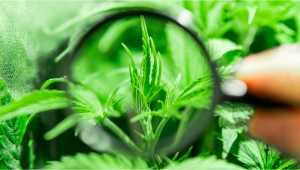


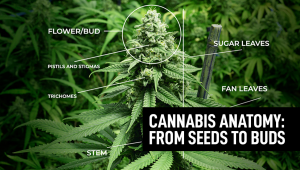
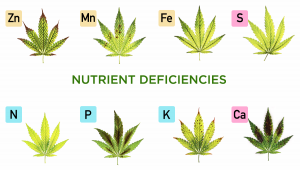
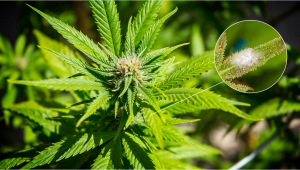
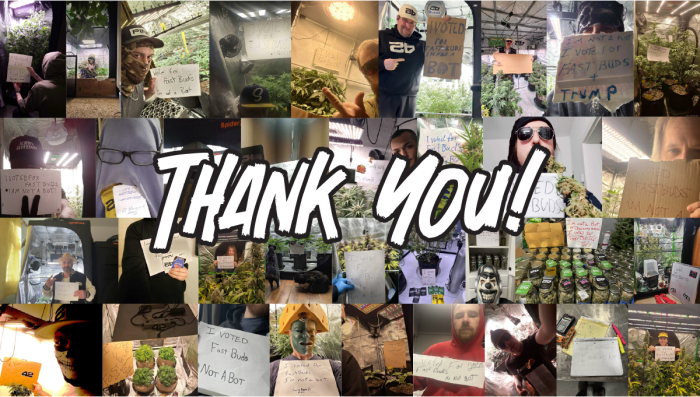

Comments